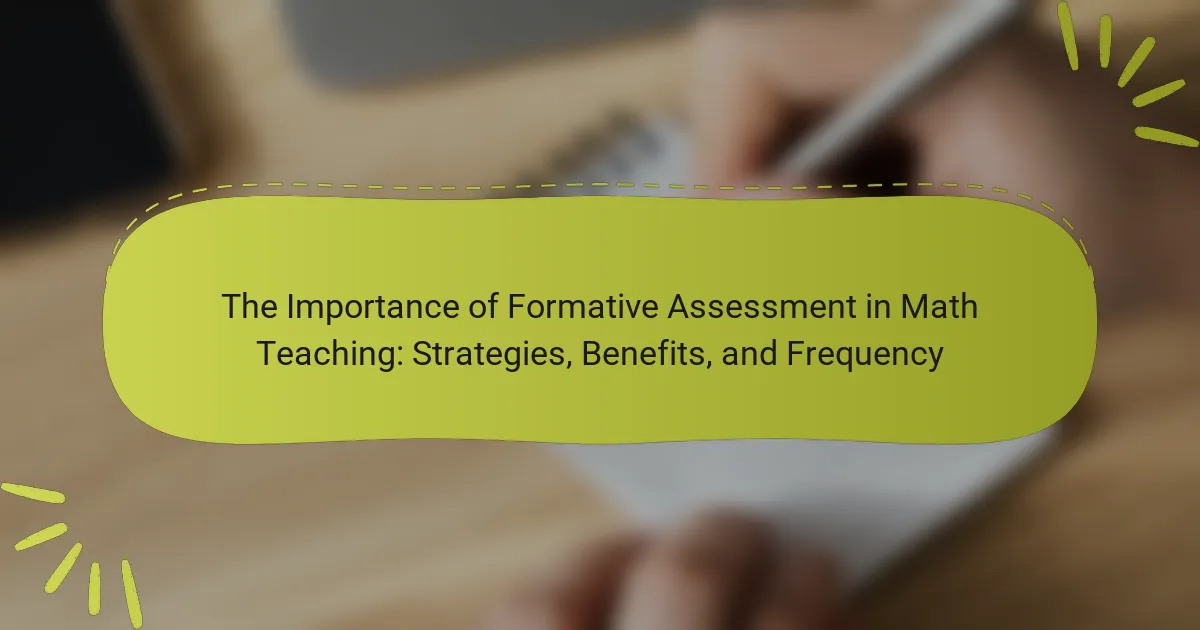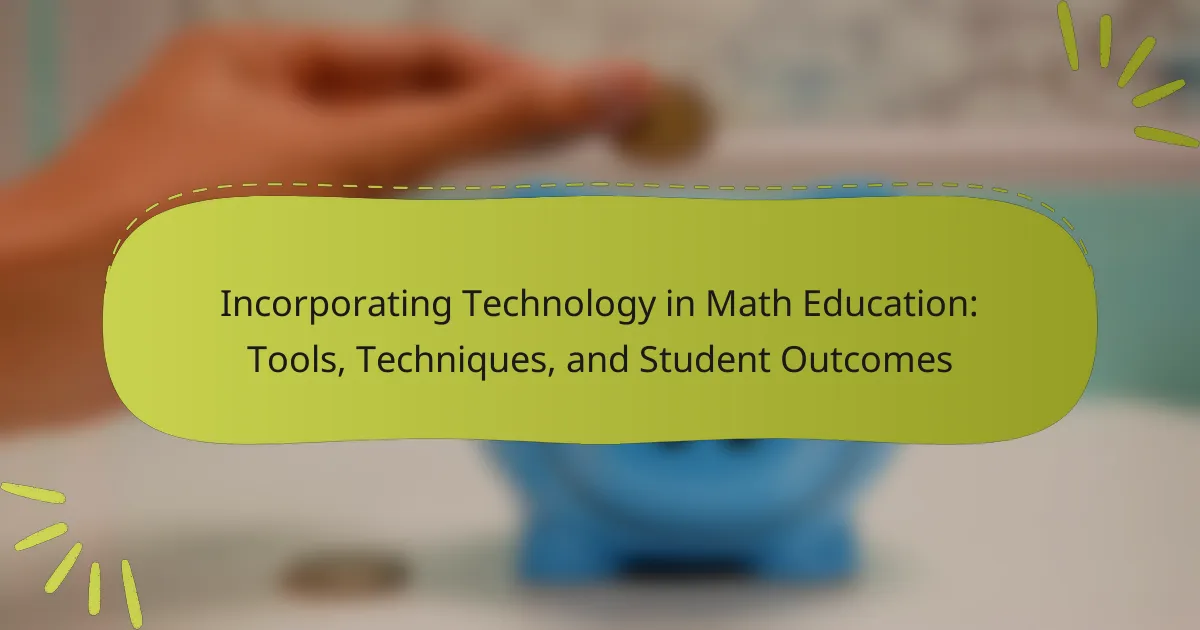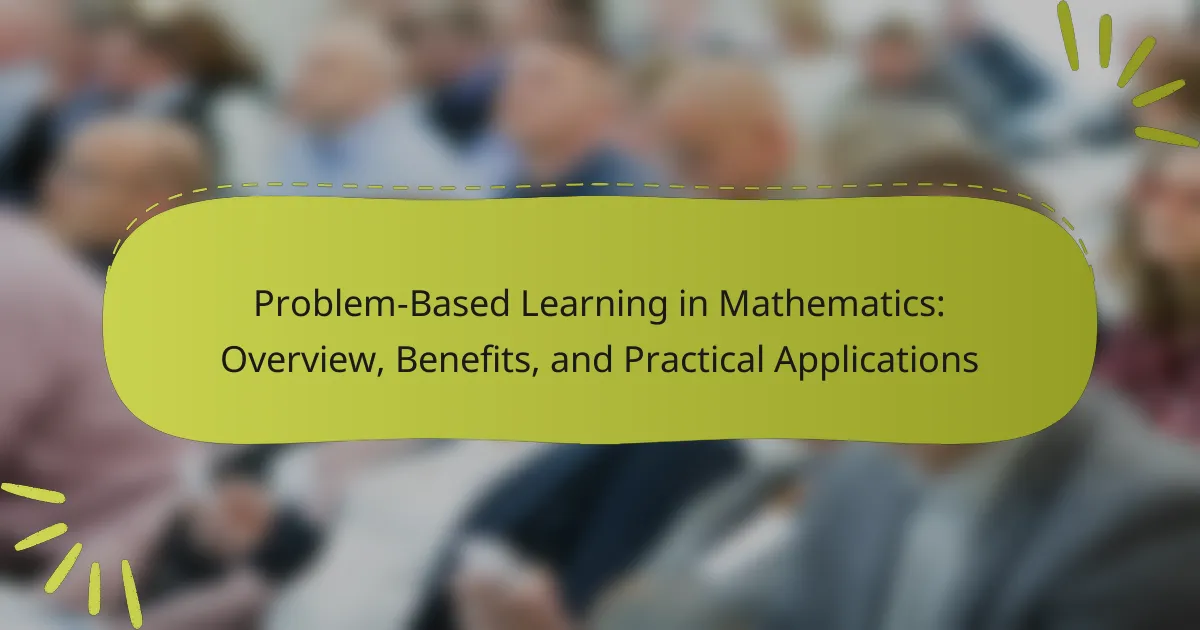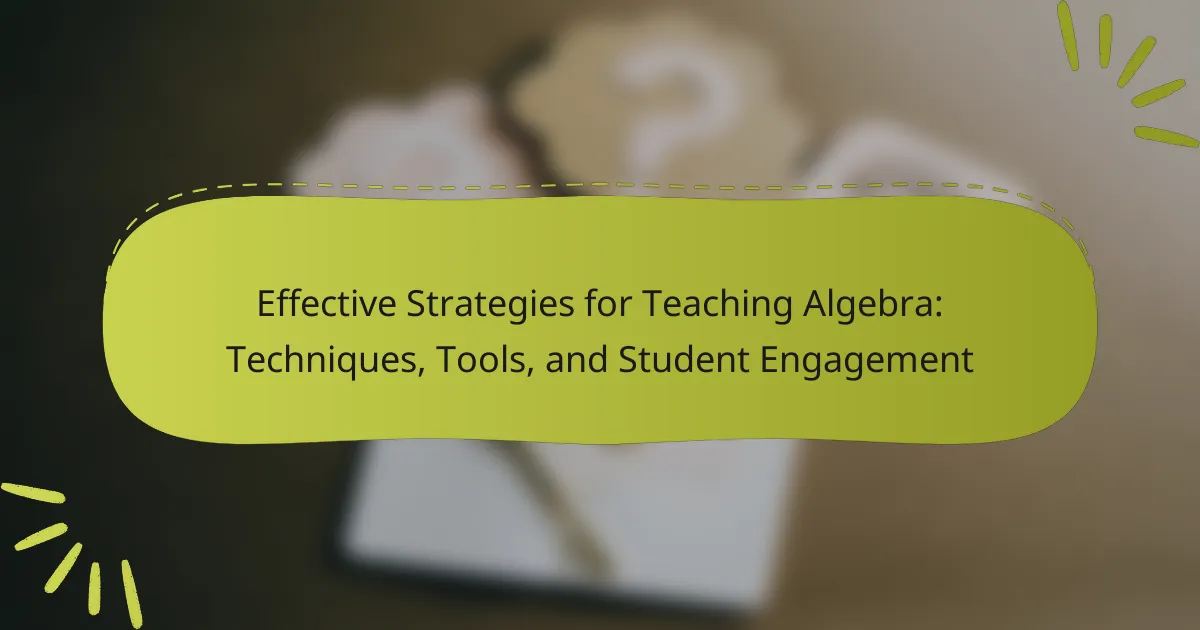Real-world math problems are practical scenarios that require mathematical reasoning and problem-solving skills, demonstrating the application of math in everyday life and various professions. This article explores effective techniques to engage students with real-world math problems, highlighting examples such as budgeting, statistics, and geometry applications. It also discusses performance-based assessments, including projects, portfolios, and collaborative evaluations, which enhance student understanding and retention of mathematical concepts. By connecting abstract math to tangible situations, these approaches foster critical thinking, collaboration, and increased motivation among students.
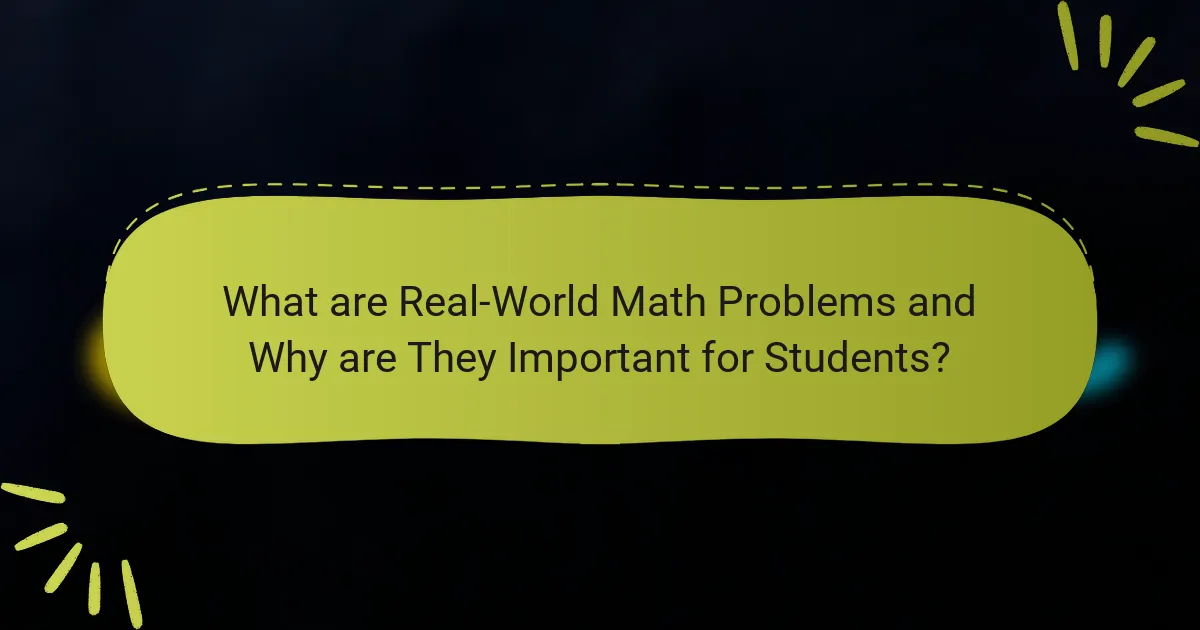
What are Real-World Math Problems and Why are They Important for Students?
Real-world math problems are practical scenarios that require mathematical reasoning and problem-solving skills. They demonstrate how math applies to everyday life and various professions. These problems help students connect abstract concepts to tangible situations. Engaging with real-world math enhances critical thinking and analytical skills. Studies show that students who tackle real-world problems exhibit improved retention of mathematical concepts. Additionally, these problems foster collaboration and communication among peers. By applying math in realistic contexts, students become more motivated and confident in their abilities.
How can real-world math problems enhance student engagement?
Real-world math problems enhance student engagement by making learning relevant and applicable. Students connect mathematical concepts to everyday situations. This connection increases their interest and motivation. Research shows that contextualized learning improves retention rates. For example, a study by the National Council of Teachers of Mathematics found that students who engage with real-world problems perform better in assessments. Furthermore, real-world scenarios foster critical thinking and problem-solving skills. They encourage collaboration among students, enhancing their social learning experience. Overall, real-world math problems create a dynamic learning environment that captivates students’ attention.
What role does relevance play in student motivation?
Relevance significantly enhances student motivation. When students perceive the material as applicable to their lives, they become more engaged. Relevant content connects academic concepts to real-world situations. This connection fosters a sense of purpose in learning. Studies show that students are more likely to invest effort in subjects they find meaningful. For instance, a study by the National Research Council found that relevance increases students’ intrinsic motivation. This intrinsic motivation leads to better academic performance and persistence. Therefore, integrating relevant examples into lessons is crucial for motivating students.
How do real-world applications improve understanding of mathematical concepts?
Real-world applications enhance understanding of mathematical concepts by providing practical contexts for abstract ideas. When students see math in action, they grasp its relevance. For instance, using budgeting in personal finance illustrates algebraic equations. This approach connects theory to practice, making learning more engaging. Studies show that students who apply math to real-life scenarios retain information better. Research by the National Council of Teachers of Mathematics supports this, indicating that contextual learning improves problem-solving skills. Engaging with real-world problems fosters critical thinking and encourages deeper exploration of mathematical principles.
What are some common techniques for presenting real-world math problems?
Common techniques for presenting real-world math problems include contextualization, visualization, and problem-based learning. Contextualization involves relating math problems to real-life scenarios that students can relate to. Visualization uses graphs, diagrams, or models to represent mathematical concepts visually. Problem-based learning engages students in solving complex, real-world problems, fostering critical thinking. These techniques enhance student engagement and understanding. Research shows that students retain information better when math is connected to real-life applications.
How can project-based learning be utilized in math education?
Project-based learning can be utilized in math education by engaging students in real-world problem-solving scenarios. This approach allows students to apply mathematical concepts to practical situations. For example, students can work on projects like budgeting for a school event or designing a small business plan. These projects require them to use arithmetic, geometry, and data analysis skills. Research shows that project-based learning improves student motivation and understanding of mathematical concepts. A study by Thomas Markham highlights that students retain information better when they learn through practical applications. Thus, project-based learning effectively enhances math education by making it relevant and engaging.
What is the significance of collaborative learning in solving math problems?
Collaborative learning is significant in solving math problems because it enhances understanding and retention of mathematical concepts. When students work together, they share diverse perspectives and strategies. This interaction fosters critical thinking and problem-solving skills. Research shows that collaborative learning can lead to improved academic performance. A study by Johnson and Johnson (1999) found that students engaged in cooperative learning scored higher on math tests. Collaborative environments also promote communication skills and build confidence. Additionally, students learn to approach problems from multiple angles, which deepens their comprehension. Overall, collaborative learning is a powerful tool in math education.
How can technology be integrated into real-world math problem solving?
Technology can be integrated into real-world math problem solving through various tools and applications. For instance, graphing calculators enable students to visualize mathematical concepts. Software like GeoGebra allows for dynamic geometry exploration. Online platforms provide interactive simulations to model real-life scenarios. Additionally, coding tools facilitate problem-solving through algorithms. Mobile apps can offer practice problems tailored to students’ needs. Data analysis tools help in interpreting real-world data sets. These technologies enhance engagement and understanding in mathematics.
What tools and resources are available for teachers?
Teachers have access to various tools and resources to enhance their teaching. Digital platforms like Google Classroom facilitate assignment management and communication. Educational websites such as Khan Academy offer free math resources and interactive lessons. Math software like GeoGebra allows for dynamic geometry and algebra exploration. Online forums provide peer support and shared resources. Professional development workshops help teachers improve their skills. Additionally, textbooks and curricula designed for real-world applications support lesson planning. These resources collectively aid teachers in effectively engaging students with real-world math problems.
How does technology facilitate interactive learning experiences?
Technology facilitates interactive learning experiences by providing tools that enhance engagement and collaboration. Digital platforms enable real-time communication among students and instructors. Interactive software allows for hands-on practice and immediate feedback. Virtual reality immerses learners in realistic scenarios, making concepts more relatable. Gamification introduces competitive elements that motivate students to participate actively. Data analytics tracks student progress, enabling personalized learning paths. According to a study published in the Journal of Educational Technology & Society, technology integration improves student achievement by 20%. This demonstrates the positive impact of technology on interactive learning.
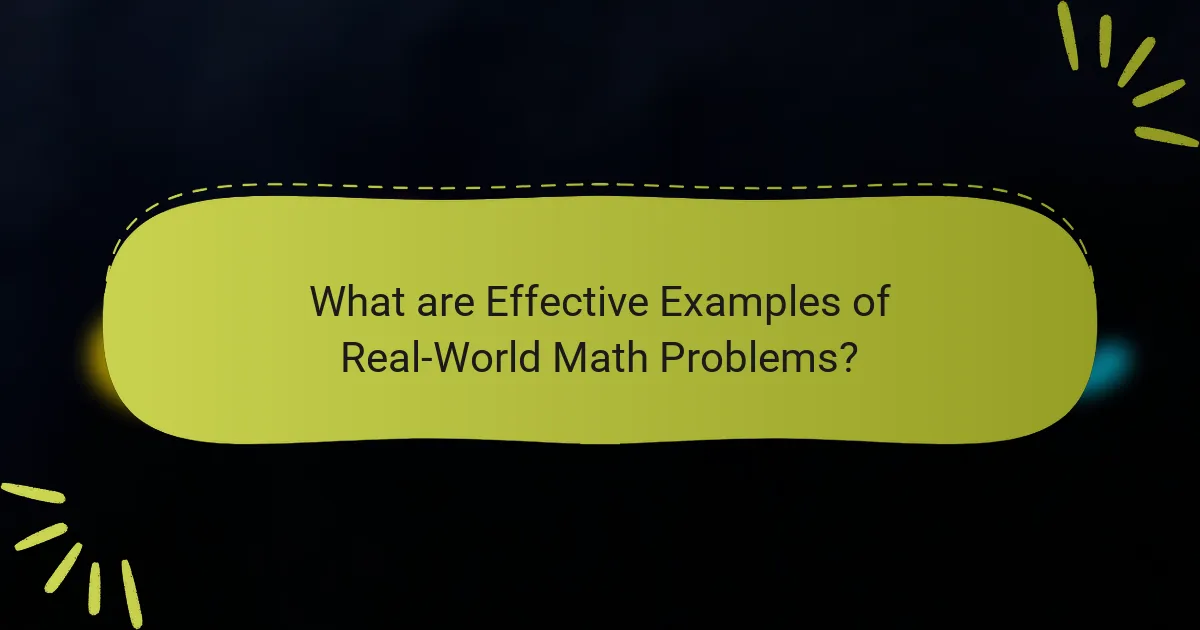
What are Effective Examples of Real-World Math Problems?
Effective examples of real-world math problems include budgeting, statistics, and geometry applications. Budgeting problems involve calculating expenses and savings over a month. For instance, students can analyze their monthly income and expenditures to create a budget.
Statistics problems can include interpreting data from surveys or experiments. For example, students might analyze the average test scores of a class to determine overall performance.
Geometry applications often involve real-life scenarios such as calculating the area of a garden or the volume of a swimming pool. Students can measure dimensions and apply formulas to find these values.
These examples engage students by connecting math to everyday situations. They help illustrate the practical utility of mathematical concepts.
What types of real-world scenarios can be used in math problems?
Real-world scenarios used in math problems include financial budgeting, cooking measurements, and construction planning. Financial budgeting involves calculating expenses and savings. Cooking measurements require converting units for recipes. Construction planning uses geometry to determine material quantities. These scenarios enhance practical understanding of mathematical concepts. They relate math to everyday life, making it more relevant. Engaging students with such examples improves their problem-solving skills.
How can everyday situations be transformed into math problems?
Everyday situations can be transformed into math problems by identifying quantifiable elements within those scenarios. For example, cooking can involve measuring ingredients, which translates to fractions and ratios in math. Shopping scenarios can involve calculating total costs or discounts, representing addition and percentage problems. Travel situations can involve distance and time, leading to problems on speed and rates. Each of these examples reflects how real-life contexts can provide practical applications of mathematical concepts. This approach helps students relate math to their daily experiences, enhancing engagement and understanding.
What are examples of math problems based on current events or local issues?
Examples of math problems based on current events or local issues include analyzing COVID-19 infection rates. Students can calculate the percentage increase or decrease in cases over a week. Another example is budgeting for community projects. Students can use local government budgets to create financial projections based on proposed expenditures.
Climate change can also be a topic for math problems. Students can analyze data on temperature changes over the last decade. They can calculate the average annual temperature increase in their region.
Local traffic patterns provide another opportunity. Students can gather data on traffic volume during rush hours and calculate average speeds. They can also determine the impact of new road construction on travel times.
These examples illustrate how math can be applied to real-world situations, making learning relevant and engaging.
How do different grade levels approach real-world math problems?
Different grade levels approach real-world math problems with varying complexity and methods. In elementary grades, students often use concrete objects and visual aids to understand basic concepts. They might solve problems related to everyday situations, such as counting items or measuring ingredients.
As students progress to middle school, they begin to apply mathematical concepts to more abstract scenarios. They tackle problems involving ratios, percentages, and basic algebra. This stage often includes projects that require data collection and analysis, such as surveys or budgeting exercises.
In high school, students engage with real-world problems through advanced topics like calculus and statistics. They analyze real data sets and apply mathematical modeling to solve complex issues. Projects may involve research on economic trends or environmental data analysis.
Each grade level builds on the previous one, enhancing students’ problem-solving skills and mathematical reasoning. Research shows that this progression helps students connect math to their lives, fostering a deeper understanding and appreciation for the subject.
What examples are suitable for elementary students?
Examples suitable for elementary students include word problems based on everyday scenarios. For instance, using shopping scenarios helps students understand addition and subtraction. A problem could involve calculating the total cost of items in a cart. Another example is using sports statistics to teach averages and data interpretation. Students can analyze their favorite athletes’ scores. Garden planning can also serve as a practical example. Students can calculate the area needed for planting flowers. Cooking measurements provide real-life applications for fractions. These examples engage students and make math relatable.
How can middle school and high school students tackle more complex problems?
Middle school and high school students can tackle more complex problems by employing critical thinking and problem-solving strategies. They should break down problems into smaller, manageable parts. This approach allows them to focus on one aspect at a time. Students can also use visual aids, such as diagrams or charts, to better understand relationships between elements in a problem. Collaborative learning is beneficial; discussing problems with peers can lead to new insights. Students should practice regularly with real-world scenarios to enhance their skills. Research shows that students engaged with practical applications of math perform better in problem-solving tasks. For instance, a study by the National Council of Teachers of Mathematics emphasizes the importance of contextual learning in mathematics education.
What are some interdisciplinary approaches to real-world math problems?
Interdisciplinary approaches to real-world math problems include integrating math with science, art, and social studies. For example, in environmental science, students use statistics to analyze climate data. In art, geometry helps in understanding symmetry and proportions in design. Social studies projects often utilize math for budgeting and demographics analysis. These methods enhance problem-solving skills and contextual understanding. Research shows that such integration increases student engagement and retention of mathematical concepts. Studies indicate that students apply math more effectively when connected to real-world scenarios across disciplines.
How can math be integrated with science and social studies?
Math can be integrated with science and social studies through interdisciplinary projects. For instance, students can analyze data from scientific experiments using statistical methods. This approach enhances their understanding of both subjects. In social studies, math can be applied to interpret demographic data or economic trends. Students might calculate population growth rates or analyze historical data sets. Such integration fosters critical thinking and real-world application of mathematical concepts. Research shows that interdisciplinary learning improves student engagement and retention of knowledge.
What are the benefits of a cross-curricular approach?
A cross-curricular approach enhances student learning by integrating multiple subjects. This method promotes deeper understanding of concepts through real-world applications. Students develop critical thinking skills as they make connections across disciplines. Engagement increases when lessons relate to students’ interests and experiences. Research shows that cross-curricular strategies improve retention of knowledge. For example, a study by Beane (1997) highlights significant gains in student motivation and performance. Additionally, collaborative projects foster teamwork and communication skills. Overall, a cross-curricular approach prepares students for complex problem-solving in diverse contexts.
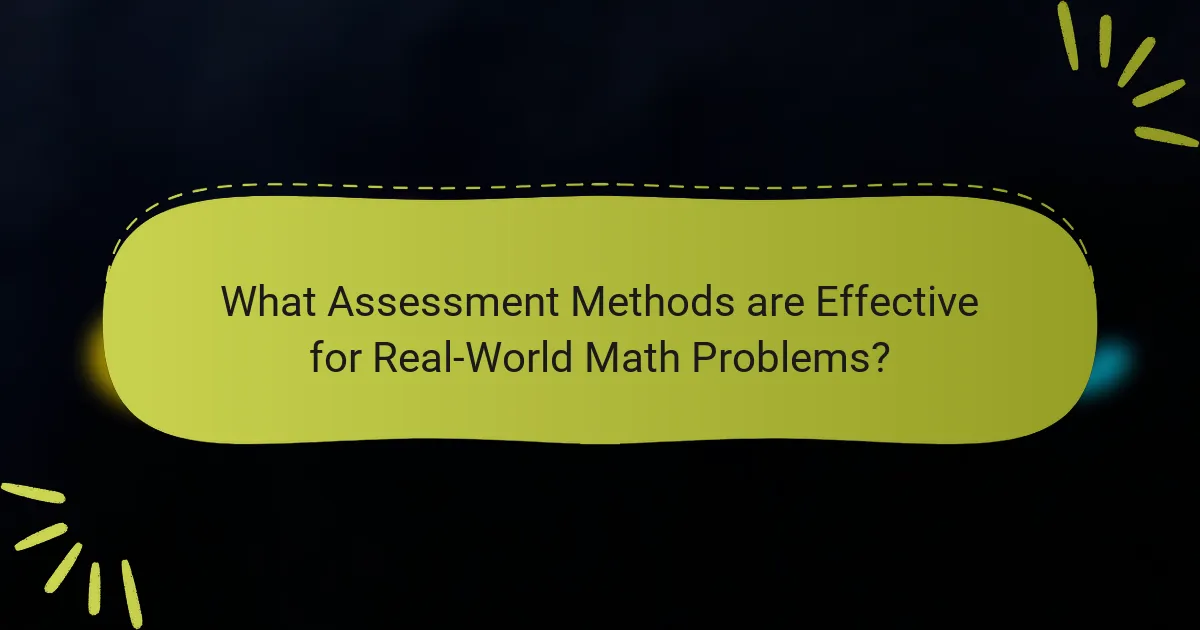
What Assessment Methods are Effective for Real-World Math Problems?
Performance-based assessments are effective for real-world math problems. These assessments require students to apply math concepts in practical situations. For example, projects that simulate real-world scenarios can enhance understanding. Additionally, portfolios showcasing student work demonstrate growth over time. Formative assessments, like quizzes and reflections, provide ongoing feedback. They help identify areas needing improvement before final evaluations. Collaborative assessments, where students work in groups, promote teamwork and problem-solving skills. Research indicates that these methods improve student engagement and retention of mathematical concepts.
How can teachers assess student understanding of real-world math problems?
Teachers can assess student understanding of real-world math problems through various methods. They can use formative assessments like quizzes and class discussions to gauge comprehension. Observations during group work provide insights into student collaboration and problem-solving skills. Teachers can also assign real-world projects that require applying mathematical concepts. These projects can showcase students’ ability to connect math to everyday situations. Additionally, reflective journals allow students to express their thought processes. Analyzing student responses reveals their understanding and misconceptions. Overall, diverse assessment methods ensure a comprehensive evaluation of student understanding.
What types of assessments can be used to evaluate problem-solving skills?
Types of assessments used to evaluate problem-solving skills include performance assessments, standardized tests, and formative assessments. Performance assessments require students to solve real-world problems, demonstrating their ability to apply knowledge. Standardized tests often include problem-solving sections that assess analytical skills under timed conditions. Formative assessments provide ongoing feedback through quizzes, peer reviews, and classroom discussions. Each type measures different aspects of problem-solving, ensuring a comprehensive evaluation of student capabilities.
How can formative assessments provide insight into student progress?
Formative assessments provide insight into student progress by continuously evaluating understanding during the learning process. These assessments include quizzes, discussions, and observations that help identify student strengths and weaknesses. Regular feedback from formative assessments allows educators to adjust instruction based on student needs. Research shows that formative assessments can lead to a 30% increase in student achievement when used effectively. This data highlights the importance of using these assessments to inform teaching practices and support student learning.
What role does feedback play in the assessment of real-world math problems?
Feedback is essential in assessing real-world math problems. It guides students in understanding their mistakes. Constructive feedback helps clarify concepts and improve problem-solving skills. It also encourages a growth mindset, promoting perseverance in challenging tasks. Studies show that timely feedback can enhance student learning outcomes significantly. For instance, research by Hattie and Timperley indicates that feedback can increase student achievement by up to 30%. Thus, feedback plays a critical role in facilitating deeper comprehension and application of mathematical concepts in real-world contexts.
How can constructive feedback enhance learning outcomes?
Constructive feedback enhances learning outcomes by providing specific guidance for improvement. It helps students identify their strengths and weaknesses. This type of feedback encourages self-reflection and critical thinking. When students understand their mistakes, they can adjust their learning strategies. Research shows that timely feedback can increase student performance by up to 30%. According to Hattie and Timperley’s study, effective feedback is one of the most powerful influences on learning. Constructive feedback also fosters a growth mindset, motivating students to persist through challenges. Overall, it creates a supportive learning environment that promotes continuous improvement.
What strategies can be used to provide effective feedback?
Effective feedback strategies include being specific, timely, and constructive. Specific feedback focuses on particular aspects of performance. Timely feedback is given soon after the task is completed. Constructive feedback emphasizes improvement rather than criticism. Additionally, using a positive tone encourages student engagement. Providing examples can clarify expectations. Encouraging self-reflection helps students learn from their experiences. Research shows that effective feedback can enhance student learning outcomes significantly.
What best practices should educators follow when assessing real-world math problems?
Educators should ensure assessments of real-world math problems are authentic and relevant. Assessments should reflect real-life situations that students may encounter. Incorporating collaborative problem-solving can enhance engagement and understanding. Providing clear rubrics helps students understand expectations and criteria for success. Offering timely feedback allows students to learn from their mistakes and improve. Differentiating assessments accommodates diverse learning needs and abilities among students. Finally, integrating technology can facilitate innovative assessment methods, making math more interactive and accessible. These practices promote a deeper understanding of mathematical concepts and their applications in real life.
How can assessments be aligned with learning objectives?
Assessments can be aligned with learning objectives by ensuring they directly measure the intended skills and knowledge. This involves designing assessments that reflect the specific learning outcomes outlined in the objectives. For instance, if a learning objective emphasizes problem-solving skills, the assessment should include real-world math problems that require those skills. Research indicates that assessments aligned with learning objectives enhance student understanding and retention. A study by Black and Wiliam (1998) highlighted that formative assessments linked to clear learning goals improve student performance. Therefore, the alignment of assessments with learning objectives is crucial for effective education.
What are some common challenges in assessing real-world math problems?
Common challenges in assessing real-world math problems include ambiguity in problem statements. Ambiguity can lead to multiple interpretations by students. Another challenge is the variability in student backgrounds and experiences. Diverse experiences can affect how students approach problems. Additionally, students may struggle with transferring theoretical knowledge to practical applications. This transfer is often difficult without proper scaffolding. Assessing problem-solving processes can also be complex. Traditional assessment methods may not capture students’ reasoning and strategies effectively. Lastly, time constraints can limit the depth of assessment. Limited time may prevent thorough exploration of real-world scenarios.
What tips can educators implement to improve student engagement with real-world math problems?
Educators can improve student engagement with real-world math problems by incorporating relevant examples. Using real-life scenarios makes math relatable to students. For instance, applying math to budgeting or cooking can spark interest.
Additionally, integrating technology enhances engagement. Tools like simulations or apps allow interactive learning experiences. Group projects encourage collaboration and problem-solving skills.
Furthermore, connecting math to students’ interests boosts motivation. If students enjoy sports, using statistics from their favorite teams can be effective.
Regular feedback also plays a crucial role in engagement. It helps students understand their progress and areas for improvement.
Finally, fostering a positive classroom environment encourages risk-taking in problem-solving. When students feel safe to express their ideas, they are more likely to engage.
The main entity of this article is real-world math problems, which serve as practical scenarios requiring mathematical reasoning and problem-solving skills. The article explores the importance of these problems in enhancing student engagement, motivation, and understanding of mathematical concepts through relevant applications. It discusses various techniques for presenting real-world math problems, such as contextualization and project-based learning, while also highlighting the role of technology and collaborative learning in the educational process. Additionally, the article examines effective assessment methods that can evaluate student understanding and problem-solving skills in real-world contexts.
